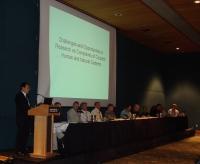To see the world clearly means opening windows in higher ed's walls
April 6, 2011
Meshing the natural sciences with social sciences to tackle some of the world’s most pressing environmental issues often flies in the face of business-as-usual for universities.
Yet the approach of coupled human and natural systems (CHANS) – holistically seeking to understand both the human systems and natural systems – offers promise of better understanding and greater impact on problems.
Some two years ago the kick-off event of the NSF-sponsored international network of CHANS research, a symposium on Complexity in Human-Nature Interactions across Landscapes, brought together leading CHANS scientists at the 2009 meeting of the U.S. Regional Association of the International Association for Landscape Ecology in Snowbird, Utah.
The latest Bulletin of the Ecological Society of America features a summary based on discussions among CHANS scientists in Snowbird entitled “Research on Coupled Human and Natural Systems (CHANS): Approach, Challenges, and Strategies.” Authors are Bill McConnell, James D.A. Millington, Nicholas J. Reo, Marina Alberti, Heidi Asbjornsen, Lawrence A. Baker, Nicholas Brozović, Laurie E. Drinkwater, Scott A. Drzyzga, José Fragoso, Daniel S. Holland, Claire A. Jantz, Timothy A. Kohler, Herbert D.G. Maschner, Michael Monticino, Guillermo Podestá, Robert Gilmore Pontius, Jr., Charles L. Redman, David Sailor, Gerald Urquhart, and Jianguo “Jack” Liu.







